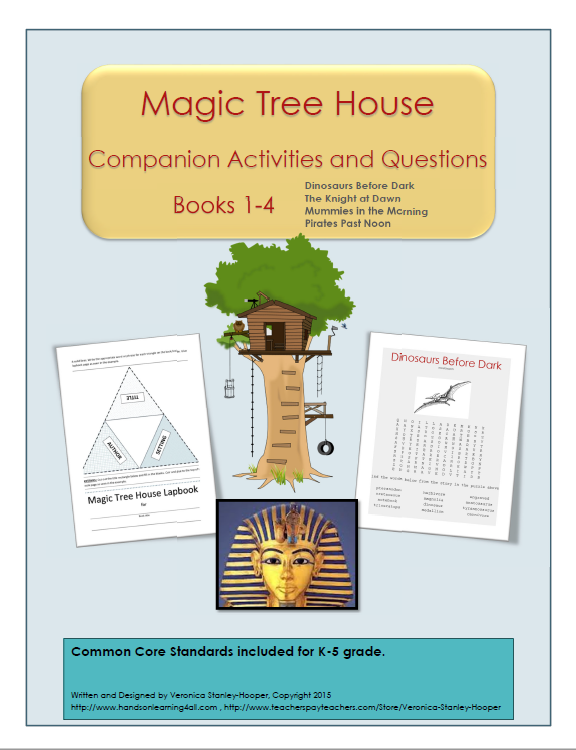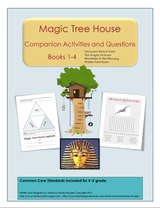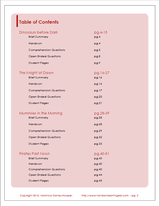Magic Tree House Comprehension and Companion Activities for Books #1-4
SKU:
$3.50
$3.50
Unavailable
per item
Instant Digital Download
This 51 page booklet is the perfect way for you to start a bookclub or literature unit with your students. It can be used for individual, small group, or whole group instruction. Great for homeschool too!
Books 1-4 of the Magic Tree House series are covered in this booklet.
Dinosaurs Before Dark
The Knight at Dawn
Mummies in the Morning
Pirates Past Noon
Each book section includes a brief book summary, 2 hands-on activity ideas, comprehension questions and answers (broken down by chapter), open-ended questions for discussion, a word search to review vocabulary, 3 lapbook sections that review characters, setting, and extension questioning, and a content review questions worksheet with answers included.
This 51 page booklet is the perfect way for you to start a bookclub or literature unit with your students. It can be used for individual, small group, or whole group instruction. Great for homeschool too!
Books 1-4 of the Magic Tree House series are covered in this booklet.
Dinosaurs Before Dark
The Knight at Dawn
Mummies in the Morning
Pirates Past Noon
Each book section includes a brief book summary, 2 hands-on activity ideas, comprehension questions and answers (broken down by chapter), open-ended questions for discussion, a word search to review vocabulary, 3 lapbook sections that review characters, setting, and extension questioning, and a content review questions worksheet with answers included.
CCSSCCRA.SL.3
Evaluate a speaker’s point of view, reasoning, and use of evidence and rhetoric.
CCSSCCRA.SL.2
Integrate and evaluate information presented in diverse media and formats, including visually, quantitatively, and orally.
CCSSCCRA.SL.1
Prepare for and participate effectively in a range of conversations and collaborations with diverse partners, building on others’ ideas and expressing their own clearly and persuasively.
CCSSRL.5.3
Compare and contrast two or more characters, settings, or events in a story or drama, drawing on specific details in the text (e.g., how characters interact).
CCSSRL.5.2
Determine a theme of a story, drama, or poem from details in the text, including how characters in a story or drama respond to challenges or how the speaker in a poem reflects upon a topic; summarize the text.
CCSSRL.5.1
Quote accurately from a text when explaining what the text says explicitly and when drawing inferences from the text.
CCSSRL.4.3
Describe in depth a character, setting, or event in a story or drama, drawing on specific details in the text (e.g., a character’s thoughts, words, or actions).
CCSSRL.4.2
Determine a theme of a story, drama, or poem from details in the text; summarize the text.
CCSSRL.4.1
Refer to details and examples in a text when explaining what the text says explicitly and when drawing inferences from the text.
CCSSRL.3.3
Describe characters in a story (e.g., their traits, motivations, or feelings) and explain how their actions contribute to the sequence of events.
CCSSRL.3.2
Recount stories, including fables, folktales, and myths from diverse cultures; determine the central message, lesson, or moral and explain how it is conveyed through key details in the text.
CCSSRL.3.1
Ask and answer questions to demonstrate understanding of a text, referring explicitly to the text as the basis for the answers.
CCSSRL.2.3
Describe how characters in a story respond to major events and challenges.
CCSSRL.2.2
Recount stories, including fables and folktales from diverse cultures, and determine their central message, lesson, or moral.
CCSSRL.2.1
Ask and answer such questions as who, what, where, when, why, and how to demonstrate understanding of key details in a text.
CCSSRL.1.3
Describe characters, settings, and major events in a story, using key details.
CCSSRL.1.2
Retell stories, including key details, and demonstrate understanding of their central message or lesson.
CCSSRL.1.1
Ask and answer questions about key details in a text.
Evaluate a speaker’s point of view, reasoning, and use of evidence and rhetoric.
CCSSCCRA.SL.2
Integrate and evaluate information presented in diverse media and formats, including visually, quantitatively, and orally.
CCSSCCRA.SL.1
Prepare for and participate effectively in a range of conversations and collaborations with diverse partners, building on others’ ideas and expressing their own clearly and persuasively.
CCSSRL.5.3
Compare and contrast two or more characters, settings, or events in a story or drama, drawing on specific details in the text (e.g., how characters interact).
CCSSRL.5.2
Determine a theme of a story, drama, or poem from details in the text, including how characters in a story or drama respond to challenges or how the speaker in a poem reflects upon a topic; summarize the text.
CCSSRL.5.1
Quote accurately from a text when explaining what the text says explicitly and when drawing inferences from the text.
CCSSRL.4.3
Describe in depth a character, setting, or event in a story or drama, drawing on specific details in the text (e.g., a character’s thoughts, words, or actions).
CCSSRL.4.2
Determine a theme of a story, drama, or poem from details in the text; summarize the text.
CCSSRL.4.1
Refer to details and examples in a text when explaining what the text says explicitly and when drawing inferences from the text.
CCSSRL.3.3
Describe characters in a story (e.g., their traits, motivations, or feelings) and explain how their actions contribute to the sequence of events.
CCSSRL.3.2
Recount stories, including fables, folktales, and myths from diverse cultures; determine the central message, lesson, or moral and explain how it is conveyed through key details in the text.
CCSSRL.3.1
Ask and answer questions to demonstrate understanding of a text, referring explicitly to the text as the basis for the answers.
CCSSRL.2.3
Describe how characters in a story respond to major events and challenges.
CCSSRL.2.2
Recount stories, including fables and folktales from diverse cultures, and determine their central message, lesson, or moral.
CCSSRL.2.1
Ask and answer such questions as who, what, where, when, why, and how to demonstrate understanding of key details in a text.
CCSSRL.1.3
Describe characters, settings, and major events in a story, using key details.
CCSSRL.1.2
Retell stories, including key details, and demonstrate understanding of their central message or lesson.
CCSSRL.1.1
Ask and answer questions about key details in a text.


